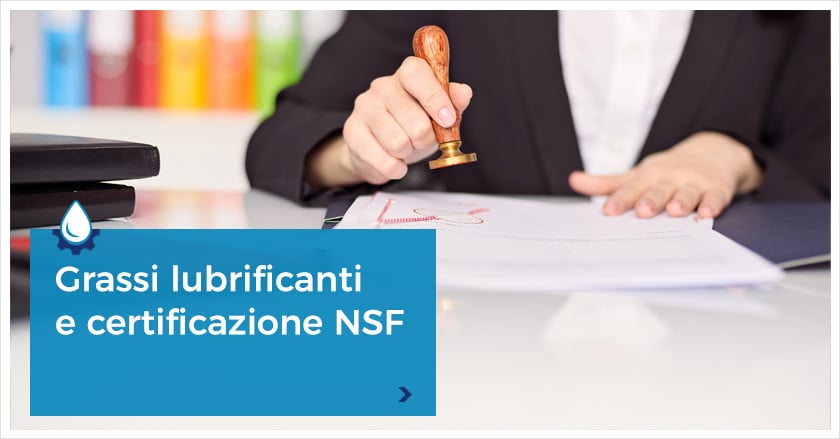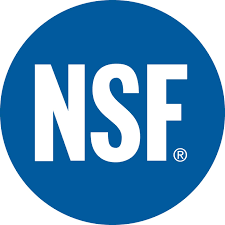
Lubricating greases and NSF certification
What are the properties of a lubricating grease for the food industry? What about NSF approval and certification? Are you sure what you put in your bearing is properly certified? Is it true that approved greases cannot be coloured? Read this article and let's see if we can resolve your doubts.
Characteristics of Lubricants for Food Use
Each specific point of application requires a particular lubricant. But, between NSF regulations, approvals and legislative constraints, the situation in the food sector is even more complicated. How many times have you heard phrases such as, "Our grease is H1-approved and is therefore fine for that bearing" or "The product you are using isn't synthetic so it is not approved and cannot be used?"
In reality, both statements contain partial truths but to what extent?

Within the food industry, a good bearing grease must have the following characteristics:
- Proper NSF certification
- Suitability with the bearing used
- Compatibility with the type of processing to which it is subjected
- Preferably of synthetic origin
- Formulated with ingredients that do not release harmful substances before, during or after application
-1.gif?width=320&height=256&name=Learn_Hydraulics_External_gear_motor%20(1)-1.gif)
1. Correct certification
The information provided by the National Sanitation Foundation, the official body on the health compatibility of products, classifies lubricants that can be used within the food industry into 2 main families:
- H1-certified lubricants are those that can accidentally come into contact with food
- H2-certified lubricants are those to be used inside machinery in closed systems, where contact with food is technically impossible
From the classification just seen, we can see that before choosing whether to use an H1 or an H2 product, it is necessary to analyse the point of application. H1-certified greases are often used only out of the fear of incurring penalties, without considering that the bearing is shielded, probably inside a fully closed crankcase and thus there is no risk of coming into contact with food. In this case, therefore, H2 certification alone would be sufficient.
Furthermore, it is always good practice to consider the requirements/approvals of the machine manufacturer relating to the plant in question. But be careful - the manufacturer often prescribes what to enter (product name, supplier, quantity) but does not prohibit the use of lubricants which, with similar or even different formulations, can satisfy the same requests (if not even behave better in some cases).
2. Suitable for a specific bearing
Obviously, the above cannot extend beyond the analysis of the point of application of the lubricant. Particularly:
- The viscosity of the base oil
- The nature of the thickener
- The type of additives inserted, which characterise the anti-wear and anti-corrosive properties
- Adhesiveness
- Compatibility with seals and elastomers
3. Compatible with the type of processing
It is also important to consider the operating conditions to which our lubricant is subject. In a cooking oven, for example, we must check with our supplier that the composition is such as to guarantee resistance to high temperatures.
We should also check that the product used (or set to be use) maintains its food grade performance even at those temperatures. At this point, an analysis of the safety data sheet will also become necessary, in particular in the sections of the composition/information on the ingredients (see Point 3), on the physical and chemical properties (Point 9) and on the toxicological (Point 11) and ecological information (Point 12).
4. Synthetic origin
A food-grade lubricant does not necessarily have to be synthetic in nature, although this choice is certainly to be preferred for two reasons. One is better performance than a mineral-based lubricant and the other, a lower tendency for the proliferation of microorganisms.
As such, it is essential - especially in cases where long lubrication cycles are concerned - to use synthetic-based products such as:
- PolyAlphaOlefin (PAO)
- PolyOlether (POE)
- Polyglycol (PG)
- Poly Alkylene Glycol (PAG)
This is in order to eliminate and/or minimise the proliferation of microorganisms (in particular fungi, bacteria and moulds) which would inevitably affect the organoleptic qualities of the finished product.
It is also necessary to eliminate any preconception linked to the colour of the lubricant. In the past, white was the "let-through" for an H1 or H2 certification but the continuous evolution in the formulation of new lubricants has also dispelled this myth. Certainly, white is preferable in terms of:
- A clean image (some industrial companies do not accept formulations that are not white)
- Possibility of visually confirming new lubricant (maintenance technicians want to quickly tell if it has been used on a mechanical component before and a different colour would make it easy to conceal this)
- Immediate visual assessment of the "conformity" of the product to the specific requests (a lack of homogeneity or presence of impurities would be immediately detected during initial visual inspection)
NOTE: A different colour does not necessarily affect the suitability or certification of the grease. We have several deliberately-coloured formulations (by choice of the manufacturer or for marketing reasons) that are equally usable and certified for contact with food.
5. Absence of dangerous substances
We are not able to exactly determine all the possible chemical combinations that occur within the formulation, handling and use of lubricants once applied by the customer. Therefore, we must carefully check - together with our supplier - that no ingredients containing heavy elements (such as antimony, lead or selenium) have been deliberately included whilst also ensuring that interactions with our system have also been considered.
The presence of such components could in fact alter the entire processing cycle.
Conclusions
Basically, a food-grade lubricant product must be free of ingredients that can release toxic substances at any stage of the life inside the bearings. Therefore, we have to take into consideration all factors concerned and, only once we have analysed the technical requirements (Point 3), the application needs (Point 4) and the main points of the safety datasheet, can we proceed with the correct selection of the our NSF H1- or H2-certified lubricant product.



